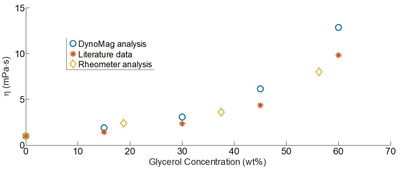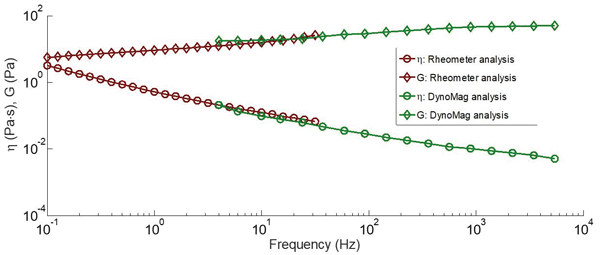Nano-viscosity measured with AC-Susceptometer DynoMag
Magnetic nanoparticles can be used to measure the viscosity of a liquid. This fact has just been established in a publication by Professor Christer Johansson (RISE Acreo, Gothenburg) and his team [1].
The principle behind it is stunningly simple: In an alternating magnetic field, magnetic nanoparticles (MNP), suspended in a liquid, can either be subject to Néel or Brownian relaxation. When they behave according to Brownian relaxation, particle and particle moment rotate as a whole with the AC carrier wave.
The viscosity η of the surrounding medium has an impact on the rotation dynamics, which directly influences the Brownian relaxation time τB:
τB=(3VH η)/(kT) [2]
VH: hydrodynamic radius
k: Boltzmann constant
T: temperature
DynoMag measures the in-phase (real component) and out-of-phase (imaginary component) of the AC-susceptibility versus frequency over a wide frequency range and on various samples. Fig. 1 shows the susceptibility of a sample with a Brownian relaxation frequency of 1 kHz (corresponding to a magnetic nanoparticle system with particle diameter of 75 nm in water at 295 K). The diagram shows the real and imaginary parts. When the viscosity of the surrounding medium increases, the relaxation time also increases and the relaxation frequency decreases. This means there is a correlation between viscosity and the changes when all other parameters stay the same (temperature, particle characteristics like size distribution etc.).
In this publication [1], mixtures of water with glycerol and water with varying amounts of xanthan gum are analize. The first is a so-called Newtonian fluid, the second behaves like a non-Newtonian fluid. Xanthan gum is a natural polysaccharide and is used as thickening agent in foodstuffs. As the water-xanthan gum mix shows non-linear flow properties, it is called non-Newtonian fluid. Other know non-Newtonian fluids are blood, ketchup or quicksand.
Fig. 2 shows the viscosity of water-glycerol in various compositions. It shows AC susceptibility analysis with DynoMag, a common rheometer and values derived from literature. Fig. 3 shows results for the water-xanthan gum mix (1 %). Again, as a comparison between DynoMag and conventional measurements.
Both systems show good compliance of the nano-viscosity with the viscosity determined by conventional measurements. Note that 200 µL of the sample are enough for measurements with DynoMag which makes it the ideal tool for applications where only small amounts of a sample are available.
[1] T. Sriviriyakul et al. „Nanorheological studies of xanthan/water solutions using magnetic nanoparticles”, Journal of Magnetism and Magnetic Materials 473 (2019) 268–271
doi.org/10.1016/j.jmmm.2018.09.103
[2] S. Bogren et al. “Classification of Magnetic Nanoparticle Systems — Synthesis, Standardization and Analysis Methods in the NanoMag Project”, International Journal of Molecular Sciences 16 (2015) 20308–20325
doi.org/10.3390/ijms160920308
[3] DynoMag Handbook 2017
Available upon request


![Real and imaginary part of the AC susceptibility versus frequency [3] Real and imaginary part of the AC susceptibility versus frequency [3]](/fileadmin/Mediapool/spectrum/154/154_ku_rise_dynomag_1.png)



